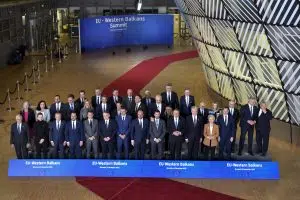Brussels – After the green light for the new investment package for the Western Balkans included in the mid-term EU budget review, some concerns are emerging in Luxembourg about the sustainability of the Euro 6 billion Western Balkans growth plan for 2024-2027. “There is a risk that the disbursement conditions are not ambitious enough and that the indicators are not sufficiently clear and measurable. It also remains difficult to ensure that reforms will be sustainable, particularly in view of the region’s weak administrative capacity,” the European Court of Auditors warned in a report about the protection of additional funds made available from Brussle to Albania, Bosnia and Herzegovina, Kosovo, North Macedonia, Montenegro, and Serbia. 
According to the report signed by the person in charge of the file, Laima Liucija Andrikienė, European auditors “welcome” the introduction of stricter conditions for financing through the new Instrument, linking payments for the region’s still “insufficient” economic convergence to the fulfillment of reforms set out in each country’s agendas. However, no criticism is spared to the EU Commission for only planning to make observations, while it should also be able to “require Western Balkan governments to review and modify their Reform Agendas accordingly,” based on “relevant guidelines” for their assessment.
The ECA report then focuses on significant financial support. The Growth Plan for the Western Balkans envisages 6 billion euros – 2 billion as grant support and 4 billion in loans – over four years: amounts that represent a “substantial increase in projected funding” until 2027, amounting to “more than 40 percent” of the 14 billion euros already made available to pre-accession countries for the same period. The European auditors acknowledge that the Facility and its allocation reflect the need for convergence of the Balkan economies to those of the 27 Member States and the benefits of the measures at a social and political level as well. However, “in the absence of an impact assessment or an analytical document,” it is impossible to quantify “the extent to which the intended €6 billion in support is likely to contribute to achieving the facility’s main objectives,” the report warns.
What is the Western Balkans Growth Plan
European Commission President Ursula von der Leyen extensively anticipated the Growth Plan for the Western Balkans and illustrated it to stakeholders during her latest fall tour of the region before its official presentation on November 8, along with the publication of the EU Enlargement Package 2023. “It is outstanding. We know that the miracle of prosperity comes with access to the Single Market, and we are already starting this process. We are not waiting for the final decision on political accession,” the number one EU executive claimed, outlining the four pillars of a Plan that should both “close the economic and social gap” between the EU and the Balkan region and allow “integration on the ground even before they formally enter as member countries.”

The first pillar was economic integration in the Single Market in seven key areas, subject to alignment with EU rules and the opening up of relevant sectors to neighboring countries: free movement of goods, free movement of services and workers, access to the Single Euro Payments Area (SEPA), facilitation of road transport, integration and de-carbonization of energy markets, digital single market, and integration of industrial supply chains. The second pillar is internal economic integration through the Common Regional Market (based on EU rules and standards). Brussels estimates that this factor alone could potentially add 10 percent to the economies of the Balkan Six. The third pillar concerns fundamental reforms, which in the Brussels Plan ,on the one hand will support the Western Balkans’ path to EU membership, and on the other it will support foreign investment and strengthen regional stability. Investments is where the fourth pillar of EU financial assistance for reforms for all six partners comes in. Specifically, it is a new €6 billion reform and growth facility for the Western Balkans for 2024-2027, the payments of which will be tied to the implementation of agreed socio-economic reforms (just like Next Generation EU for the 27 Member States). With the interim review of the EU 2021-2027 Multi-annual Financial Framework, the green light was given to the facility comprising 2 billion euros in grants(ending up in the EU budget without changes to the Commission’s proposal) and 4 billion in concessional loans, with payment conditioned on each of the six countries submitting a reform agenda based on the recommendations of the Enlargement Package and Economic Reform Programs. 
There is an additional clause for Serbia and Kosovo. “They must engage constructively in the dialogue on normalization of relations,” President von der Leyen specified. In other words, without progress in the Pristina-Belgrade dialogue, funding under the Plan will remain stalled – or be lost. The same is true for Bosnia and Herzegovina in the event of failure to implement key reforms: “Resources will be redistributed to other countries that are able to do so. This is a strong incentive to move forward in an active way,” she warned at her November 1 stop in Sarajevo.
Find more insights on the Balkan region in the newsletter BarBalcani hosted by Eunews
English version by the Translation Service of Withub





